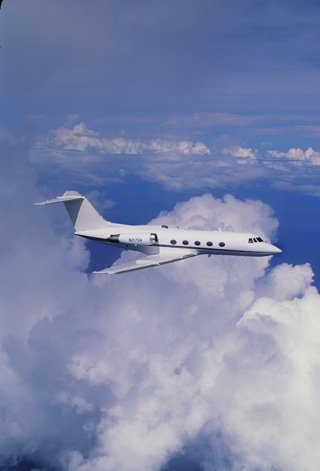Quick Look: Gulfstream II
 The Gulfstream II (G-1159) was developed in the mid-1960s by Grumman Aircraft as a successor to its Gulfstream I twin turboprop, the original purpose-built business airplane. On May 5, 1965, the production go-ahead was given for the $4 million, sweptwing, 19-passenger jet, which was powered by two aft-mounted Rolls-Royce Spey Mk 511-8 turbofans. First flight took place on October 2, 1966, at the company’s Bethpage, New York, plant, and FAA certification was granted on October 19, 1967.
The Gulfstream II (G-1159) was developed in the mid-1960s by Grumman Aircraft as a successor to its Gulfstream I twin turboprop, the original purpose-built business airplane. On May 5, 1965, the production go-ahead was given for the $4 million, sweptwing, 19-passenger jet, which was powered by two aft-mounted Rolls-Royce Spey Mk 511-8 turbofans. First flight took place on October 2, 1966, at the company’s Bethpage, New York, plant, and FAA certification was granted on October 19, 1967.
The first production GII was delivered to National Distillers and Chemical Corporation on December 6, 1967. In May 1968 that airplane became the first business jet to make a nonstop transatlantic flight, traveling from Teterboro, New Jersey, to London’s Gatwick Airport.
After the fortieth GII was built, production shifted to Savannah, Georgia, under the auspices of Grumman American Aviation, a division formed in 1973 to produce civil aircraft. Five years later, Grumman sold its interest to concentrate on production of military airplanes. The manufacturer of the Gulfstream business jets became known as Gulfstream American and later Gulfstream Aerospace.
Later models of the GII included optional fuel tanks that extended the airplane’s range by 400 nautical miles. Certificated in September 1976, the extra tanks were standard equipment beginning with serial number 198.
GII production ended in December 1979. In September 1981 the FAA certified the Gulfstream IIB, a modification that involved mating the winglet wings of the Gulfstream III to a GII fuselage. In 1994, the FAA certified installation of Aviation Partners winglets on earlier GIIs. Besides those airplanes built for corporate use, numerous military and government operators have flown special-mission GIIs, including the U.S. military and NASA—which used the aircraft to train space shuttle pilots.
Most Gulfstream IIs flying today have avionics upgrades—not only to enhance the aircraft’s capability, but also to meet regulatory requirements. The most capable airplanes are outfitted with terrain awareness and warning systems, traffic alert and collision avoidance systems, and reduced vertical separation minimums equipment.
A total of 258 Gulfstream IIs were built between 1966 and 1979, and 200 remain in service. An early model Gulfstream II costs $300,000, while the average asking price for a late-model GIIB is $800,000.
The viability of the Gulfstream II is threatened by bans on Stage 2 aircraft in many nations, including the United States after 2015. Hush kits that make the GII compliant with noise standards are available from Quiet Technology Aerospace of Hollywood, Florida, and St. Paul, Minnesota-based Hubbard Aviation Technologies—which holds the rights to a noise-suppression system developed by Stage II Technologies of La Jolla, California.
Robert A. Searles is an aviation writer and editor.


